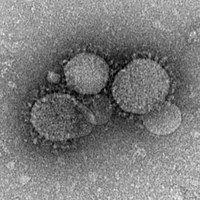
Photo from wikipedia
Myasthenia gravis (MG) is a well-known autoimmune disease affecting neuromuscular junction (NMJ). The targeted molecules of NMJ include acetylcholine receptor (AChR), muscle-specific receptor tyrosine kinase (MuSK), and low-density lipoprotein receptor-related… Click to show full abstract
Myasthenia gravis (MG) is a well-known autoimmune disease affecting neuromuscular junction (NMJ). The targeted molecules of NMJ include acetylcholine receptor (AChR), muscle-specific receptor tyrosine kinase (MuSK), and low-density lipoprotein receptor-related protein 4 (Lrp4). The prevalence of MG is remarkably increasing recently, almost doubling between 2006 and 2018 in Japan, and now it is the most common autoimmune disease affecting the nervous system. The management of MG has markedly changed in recent decades. Health-related quality of life (QOL) of patients has been considered as a most essential factor. In this issue, we tried to revisit the new clinical fundamentals of MG in the daily practice setting. In the first article, Utsugisawa et al1 reviewed the clinical and social situation involving health-related QOL. The multicenter “Japan MG Registry Study” has been focusing on QOL and they have repeatedly shown that disease severity and oral steroid dose are major independent factors negatively impacting health-related QOL in patients with MG. The former affects personal activities and the latter involves in social activities. Indeed, patients often experience unemployment and decreased income, and many patients report reduced social positivity. Therefore, the treatment goal was set to the early achievement of minimal manifestations (MM) or better status with prednisolone dose of 5 mg or below. Nonsteroidal fast-acting treatments are encouraged to use as an induction therapy, and as a result, the percentage of patients achieving this goal is increasing in Japan. We should help MG patients resume a normal lifestyle by achieving the target as soon as possible. Suzuki et al2 wrote an excellent review about anti-striational antibodies (StrAbs). Needless to mention, target of pathogenic antibodies in MG include AChR or MuSK. However, there are some antibodies that are not considered pathogenic but are playing roles in modifying the disease or being markers for certain subgroup of the disease. Autoantigens of StrAbs include titin, ryanodine receptor, and Kv1.4, and MG patients with StrAbs often suffer from relatively severe symptoms such as bulbar paresis and myasthenic crisis. The important point is that StrAbs are frequently detected in MG patients associated with myositis. Once myocarditis occurs, it could be fatal due to serious arrhythmias and severe heart failure where prompt aggressive immunotherapy is required. Therefore, it is preferable to check StrAbs in MG patients to see if patients belong to certain clinical subset. StrAbs are often detected in MG that developed in cancer patients receiving immune checkpoint inhibitors as immune-related adverse events. This is a comprehensive review to update the knowledge of StrAbs and it will contribute to the daily management of MG. Finally, Murai et al3 wrote a review on clinical guidelines/guidance for MG. A new version of the Japanese clinical guidelines for MG is under way. The current version was published in 2014, in which the top priority in treatment was to maintain patients’ health-related QOL as Dr Utsugisawa commented. Through the treatment goal of “MM or better status with prednisolone dose of 5 mg or below,” and the vigorous use of early fast-acting treatment regimen, the therapeutic tendencies in MG have been gradually changing in Japan. Murai has searched international and other nations’ guidelines/ guidance for MG and compared them with the 2014 Japanese guidelines. International consensus guidance, British guidelines, German guidelines, Italian recommendations, and Chinese guidelines were reviewed. It is of interest that each guidelines/guidance has its own characteristics. We should try to seek ideal clinical guidelines that always stand by patients. Putting together, this focused review series should be useful to the readers because these articles provide hints for the daily practice of MG. The fundamental philosophy is that vigorous efforts should be taken to nourish patients’ health-related QOL.
Journal Title: Clinical and Experimental Neuroimmunology
Year Published: 2020
Link to full text (if available)
Share on Social Media: Sign Up to like & get
recommendations!